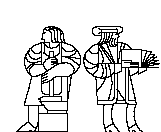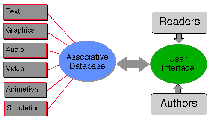
DEPARTMENT OF CHEMICAL ENGINEERING
Massachusetts Institute of Technology
Cambridge, MA 02139
Chemical Engineering Design and Hypermedia
 Gregory J. McRae
Gregory J. McRae
 Gregory C. Rutledge
Gregory C. Rutledge
Table of Contents
- Project Description
- Pressures on the Curriculum
- Integrated Chemical Engineering (ICE)
- The Hyperweb Concept
- Case Studies
- Future Directions
- Acknowledgements
- Further Information
This project targets the development of educational materials and courseware in areas of chemical engineering where rapid changes in today's technologies outpace developments in educational preparation of our young engineers. Technological problems of national and economic importance increasingly require the synthesis of solutions involving input from many new and developing technologies as well as novel applications of traditional science. Our mission is to speed the transfer of technology from the research lab to the classroom and to promote the composite design of solutions to complex problems which draw upon all aspects of the undergraduate curriculum. The means towards the accomplishment of this goal entails two components:
- Improving Problem Solving Skills
- Modularization of the chemical engineering design curriculum to exercise students in whole problem-solving methods, to expose students to areas of current technological importance and to promote faculty involvement.
- Utilization of Hypertext and Hypermedia
- Development of non-linear, linked, hypermedia-based courseware to enable rapid redesign and deployment of course materials for the evolving case studies built upon the shoulders of previous modules.
Some of the pressures on the chemical engineering curriclum include:
- Retention of fundamentals: i.e. physical chemistry, thermodynamics, transport
- Relevance of fundamentals (contextual learning)
- Synthesis of solutions to problems (design)
- Diversification of chemical engineering applications
- Rapid Evolution of new problems
In essence each of the requirements translate into the need to cover more
material in a fixed time frame. An additional constraint is the time needed
to prepare the course materials themselves.
Elements of a New Approach
In order to implement fully the modularized case study format within the constraints of time and curriculum and to enhance its versatility and rapid response capability to developing technologies, several needs arise:
- Stream-lined case development (electronic authorship).
- Repository for case study materials in multimedia-capable environment.
- Broad-based, non-sequential access to interdisciplinary materials on demand (hypermedia).
- Electronic classroom facilities for both guided and independent browsing of the resource database.
- Powerful computer platforms to access both database facilities and on-line interactive learning (i.e. simulation).
Integrated Chemical Engineering (ICE)
ICE is an alternative to the conventional chemical engineering design curriculum which is intended to promote integration of engineering skills through reduction of course-dependent learning, improvement of problem-solving skills though notion of problem definition and solution design, and enhancement of professional awareness through technological and social context.
- Case Study format (modularity)
- Provision for evolutionary development and introduction of new ideas
- High faculty participation and direct involvement.
ICE was first tested as a concept in the Department of Chemical Engineering at M.I.T. in 1989. It has met with considerable success and student response has been enthusiastic. Since that time numerous case studies have evolved. Some examples:
- design of acetic anhydride continuous production facility
- batch design of silicon-based monomer for silicones industry
- drug delivery systems
- "Polybead" design for liquid chromatography applications
- membrane design for natural gas purification
- Superfund site clean-up
- design of biodegradable polymers
- statistical design of experiments
all these pressures translate into more material to cover in a fixed timeframe and less time to develop new materials
- Modularity lends itself to evolutionary curriculum development and upgrading
- Modularity enables large faculty and industry involvement and promotes diversity in applications exposure
- Modularity enables rapid technology transfer to classroom
- Case study format emphasizes relevance and hones problem solving skills
- Design aspect draws upon basics of chemical engineering as well as of other disciplines, requires synthesis of whole problem solution
Hypermedia as envisioned here consists of multimedia objects stored in an associative database which is held together by "links", which allow non-linear or non-sequential access to the elements of the database, and interactive simulation capabilities which are accessed by and manipulated through information-passing links.
 Hypermedia Concept
Hypermedia Concept
An initial implementation of the
concept has been carried out by Patera and Sonwalker in the Department of Mechanical Engineering, M.I.T. 1994
The curricular hyperweb concept embodies a macroscale ideal in which a faculty collective which crosses traditional department boundaries works collaboratively to provide uniform access to a wide range of topical areas, designated "domains". Our modular curriculum represents a small scale model of this grand concept. Each case study represents a domain which builds on fundamental concepts, brings in new educational material and links to materials already existing within the hyperweb.
Access to graphical workstations providing adequate computational resources to allow real-time browsing, visualization and simulation is an essential element of the educational mission of bringing learning tools to the classroom. One solution is a collection of workstations equipped for either follow-along interaction in the classroom environment, or laboratory-style self-paced learning after hours.
The computer presentation scrolling on the Macintosh screen represents samples of the problem-solving approach implemented in these modules and of the simple simulations which are possible for interactive manipulations using current state-of-the-art graphical workstations.
Here is a movie of
water rotation.
Serve to demonstrate the hyperweb concept on a small scale and to test implementation of a multi-domain, evolutionary electronic courseware environment.
- Case Study: design of a biodegradable plastic with properties comparable to polypropylene
- Fundamentals: organic and physical chemistry, thermodynamics (engineering and statistical), molecular physics, mass transport, solid mechanics
- Applications: polymer engineering, environmental stewardship
- Methods: scientific visualization, group contribution estimation, molecular dynamics simulation
Module 2: Design of Environmentally Benign Chemical Processing Systems
- Case Study: Identification of alternative chemical synthesis routes and process design alternatives with a goal to improve both economic performance and environmenta quality.
- Fundamentals: mathematics (graph theory, optimization, numerical methods), organic and physical chemistry, thermodynamics, design of separation sequences, and molecular properties.
- Applications: Solvent design, identification of new processing routes, environmental stewardship.
- Methods: scientific visualization, group contribution estimation, ab initio quantum chemistry, combinatorial optimization, process synthesis and design, and high performance computing
- Implementation of hypermedia user interface (e.g. Hypercard, Mosaic)
- Electronic storage and retrieval of case study materials
- Student testing and evaluation of hyperlink web
- Expansion of electronic materials database to graduate level and advanced topics
- Storage and distribution of materials to other sites via CD-ROM and video
- BIOSYM Technologies
- Cray Research
- Digital Equipment Corporation
- MIT (Office of Dean, R.A. Brown, A. Patera, N. Sonwalkar)
- National Science Foundation
For further information contact:
Gregory J. McRae, mcrae@mit.edu
or Gregory C. Rutledge, rutledge@mit.edu
Gregory J. McRae
Gregory C. Rutledge